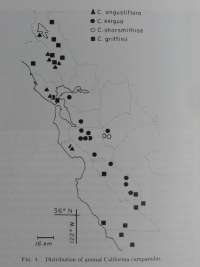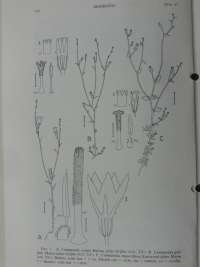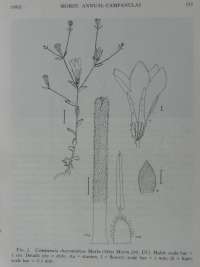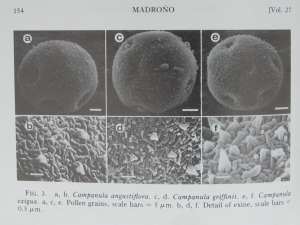Inhoud
griffinii
Campanula griffinii
Morin, nom. et stat. nov. Non Campanula exilis (A.DC.) D. Dietrich, 1839. - Type: CA: San Benito Co., the Pinnacles, 19 May 1937, Howell 12938. (Holotype:CAS!; isotypes: GH!, POM!).
The species is named in honor of James R. Griffin. His work with the pines and oaks of California is internationally recognized; less well known are his careful and insightful observations of the “belly plants” of California, particularly those found in the central Coast Ranges, and his continuous and generous help to other botanists working in the central Coast Range area.1) Originally described as Campanula angustiflora Eastwood var. exilis J.T. Howell (Leafl. W. Bot. 2:101, 1938), but here recognized at the specific level. It is suggested that Campanula griffinii is closely related to Campanula exigua. 2) All of the California annuals (Campanula angustifloar, Campanula exigua, Campanula sharsmithiae and Campanula griffinii) have been a source of confusion since their discovery, judging from the misidentifications found in herbaria, and they are not known to be closely related to any other campanulas. Treatment of small-flowered and annual Old World campanulas has been controversial (Boissier, 1874; de Candolle, 1830; Gadella, 1964, 1966; Federov, 1957), and knowledge of New World campanulas is very limited (Shetler, 1963). Here I give detailed descriptions of the Californian annual campanulas in order to facilitate eventual comparison between them and their Nort American relatives and between them and their Mediterranean counterparts.3)Taxonomic History
All of the California annuals (Campanula angustiflora, Campanula exigua, Campanula sharsmithiae and Campanula griffinii) have been a source of confusion since their discovery, judging from the misidentifications found in herbaria, and they are not known to be closely related to any other campanulas. Treatment of small-flowered and annual Old World campanulas has been controversial (Boissier, 1874; de Candolle, 1830; Gadella, 1964, 1966; Federov, 1957), and knowledge of New World campanulas is very limited (Shetler, 1963). Here I give detailed descriptions of the Californian annual campanulas in order to facilitate eventual comparison between them and their Nort American relatives and between them and their Mediterranean counterparts.4)
Habitus
Erect annuals, 2-20cm high, stems 4-angled, glabrous or hispid below first flower, or all parts hispid.
Both Campanula exigua and Campanula griffinii have narrow, somewhat sclerophyllous leaves and bracts. The bracts in both species are arranged near the apex of each branch but at least 4mm and more often 7-8mm apart. Consequently, subsequent branches are arranged alternately. Because the flowers of Campanula exigua have long pedicels and the branches are widely spaced, the plants appear very open and delicate. In contrast, the bracts of Campanula sharsmithiae are opposite or nearly so and the branches, both of which usually develop, seem superficially to be truly dichotomous. The fleshy leaves are wider than those of Campanula exigua and the plants of Campanula sharsmithiae accordingly appear to be leafier and generally denser.5)
Morphology
Morphological simularities of these taxa to other Nort American Campanulideae may be due to convergence; consequently, the relationships of these four species (Campanula angustifloar, Campanula exigua, Campanula sharsmithiae and Campanula griffinii) are obscure.
The combination of character states shared by Campanula griffinii and Campanula exigua seems to support the hypothesis that Campanula griffinii arose from a Campanula exigua-like ancestor. These character states are: narrow leaves, upper bracts closer to the flower than to the subtending leaf, longest leaf subtending first flower, capsules cylindrical with inter-rib area not infolded or tuberculate, seeds not fusiform, flattened at chalazal end, pollen pantoporate, n = 17. Because Campanula griffinii differs quantitatively in most characters from Campanula exigua, has a different breeding system, and has an independent geographical range, I consider them distinct.6)Leaves
Narrow leaves, lower cauline leaves sessile, alternate, 2-4.5mm long, broadly spatulate, obtuse, few-toothed; upper cauline leaves (3.5-)7-9mm long, linear-subulate, 4-6(-11) times as long as broad, with 4 pairs of gland-tipped teeth, abaxial sides glabrous or hispid; longest leaf subtends first flower; bracts 2.8-3.7(-5.9)mm long, lanceolate to linear, few-toothed, acute, glabrous to sparsely hirsute; lower bract closer to flower than to leaf subtending branch.
Flowers
Flowers Apr-Jul; Small flowers, terminal, pedicel 1-4.5(-6)mm long, corollas white, all parts equally UV-absorbing, 2.2-3.7mm long, cylindrical, lobes 1.2-1.4mm long, acute, erect or spreading; corolla without internal papillae; style white, 2.5mm long, papillate distally about 1/3 its length; style lobes 0.5-0.6mm long, loosely appressed at anthesis; stamens 2mm long, the anthers equal to the linear, glabrous filaments.
Ovary 1.7-3.6mm long, conical at base, the sides cylindrical, strongly ribbed; calyx lobes slightly unequal, 2.5-4.2mm long, subulate, 0.5 to 1.5 times the length of the ovary, erect in fruit.
In Campanula griffinii the trend to autogamy is one step more advanced than in Campanula angustiflora in that the corolla is usually included in the calyx lobes and the filaments are narrow and lack cilia.Pollen
Pollen 0.035mm dia., 8-pantoporate;
Most European Campanula pollen studied to date is 3- to 4-porate (Dunbar, 1975). Most North American campanulas (and other North American genera in Campanuloideae) have pollen that is 5- to 6-porate, the pores equatorial )Chapman, 1966; Chuang, pers. comm., 1978; Morin, unpubl. data). Only Campanula americana L., Campanula exgua, and Campanula griffinii are known to have pantoporate pollen, although pores of Campanula reverchonii are not strictly equatorial. Small (1903) placed Campanula americana in the monotypic genus Campanulastrum, and Gadella (1964) supported this decision. There is little morphological similarity between Campanula americana (which is a tall, broadleaved annual or biennial with spicate inflorescences and rotate corollas) and the annual California campanulas. Therefore it seems likely that pantoporate pollen evolved independently in these two groups.7)
Fruit
Capsule nearly cylindrical, slightly constricted near the middle at a point corresponding with the pore position, conspicuously ribbed, the inter-rib area not infolded or tuberculate; 0vulus 50-100, seeds 0.6mm long, twice as long as wide, oblong, elliptical in cross-section, flat on the chalazal end, light brown, shiny, finely striate (Fig.1).
Chromosomes
n = 17
Campanula angustiflora and Campanula griffinii are predominantly autogamous, an unusual character stat for the genus. These are the first annual campanulas reported to have chromosome numbers n = 15 or n = 17.8)Origin
Four of the ten species of Campanula that are found in the California Floristic Province are annuals; Campanula griffinii - Grows in the inner North Coast Ranges from east-central Lake Co., south to Tiburon Peninsula and Mt. Tamalpais in Marin Co.; South Coast Ranges from northers San Benito Co. to northern San Luis Obispo Co. (Fig.4).9)
Living
Extensive populations on serpentine soil under chaparral shrubs.
Methods
Seeds of field-collected plants were grown at the University of California Botanical Garden in pots of “UC Mix, formula C” soil (Matkin and Chandler, 1957), in insect exclosures, for studies of morphology, cytology, and pollination system. Seed sources are indicated in the Taxonomic Treatment and included at least one northers and one southern population of each species except Campanula sharsmithiae, seeds of which were not available. Voucher specimens are in UC.
Buds from field-collected and garden-grown plants were preserved in Carnoy's 6:3:1 solution; microsporocytes were stained in acetocarmine for chromosome preparations. Pollen was mounted in lactophenol and cotton blue for study of general morphology and was prepared following the method of Lynch and Webster (1975) for study of exine ultrastructure, except that material was CO2-critical-point-dried directly from 100 percent ethanol. After initial preparation the pollen was coated with 30nm of gold palladium and viewed on a Coates and Welter Model 50 Emission Scanning Electron Microscope.
Measurements of vegetative and floral parts were made on pressed, garden-grown plants and on herbarium specimens from BR, CAS, CU, DAV, DS, GH, JEPS, K, MICH, MO, ND, NO, NY, ORE, OSC, PH, POM, RSA, SBBG, UC, UCSB, US, UTC, WS, and WTU. Corollas of living plants were photographed in direct sunlight with a Tiffin 18A Photar filter with high speed Ektachrome and Tri-X films to document ultraviolet (UV) absorptions patterns.
Flowers of carpellate parents in artificial crosses were emasculated before anthesis and later pollinated by transferring pollen from the style of the staminate parent, on sterile forceps, to the stigmatic surface of the carpellate parent. Except when they were being manipulated, the flowers were covered with Kimwipe bags before anthesis with no further treatment. Self-compatibility of Campanula exigua was tested by transferring pollen from the style to the stigma of the same flower. Pollen is deposited on the stigmatic area of Campanula angustiflora and Campanula griffinii before anthesis and therefore was not artificially transferred. Presence of apomixis was tested by leaving emasculated flowers unpollinated.
Results of methods
The two most obvious characters that separate these annual species are leaf width and corolla size (Figs. 1 and 2).
Campanula exigua and Campanula sharsmithiae have large flowers. The former has thin, narrow leaves and the latter has fleshy, broader leaves. Campanula griffinii has narrow leaves and small flowers, and Campanula angustiflora has broad leaves and small flowers. These species also differ in ovary shape, filaments shape, and position of upper bracts. These characters, along with flower size and leaf shape, are more constant under garden conditions than most other characters. For this reason, they were chosen as major, differentiating characters.
Campanula exigua, Campanula sharsmithiae and Campanula griffinii have n = 17, wheras Campanula angustiflora has n = 15; they are the first annual campanulas reported to have these numbers. At least two populations of each species (only one for Campanula sharsmithiae) were counted; vouchers are deposited in UC and indicated in the Taxonomic Treatment.
Campanula exigua has 12-pantoporate pollen, Campanula sharsmithiae has 14-20 pantoporate pollen, and Campanula griffinii has 8-pantoporate pollen (Fig.3). Pantoporate pollen in Campanulaceae has previously been known only from Campanula americana (Dunbar, 1975), Campanula angustiflora has 6-porate pollen, the pores equatorial (Fig.3). Following the terminology used by Dunbar (1975), pollen sexine fine structure for the species studied can be described as short ridges, tip end bent upwards, with basally divided spinules (Fig.3).
Reciprocal crosses among all species were unsuccessful. Unemasculated, bagged flowers and unbagged flowers of Campanula angustiflora and Campanula griffinii set seed (50-80 seeds per capsule), but emasculated, unpollinated flowers did not produce seed. These two species are self-pollinating and self-compatible; they do not appear to be apomictic, but pseudogamy cannot be ruled out. No flowers of Campanula exigua produced seed. Since even control, intrapopulational crosses were unsuccessful even though flowers in the field produce up to 100 seeds each, failure may have been due to technical problems such as mechanical damage to the stigma. Campanula exigua is not self-pollinating and seems to be self self-incompatible.




